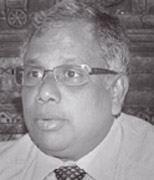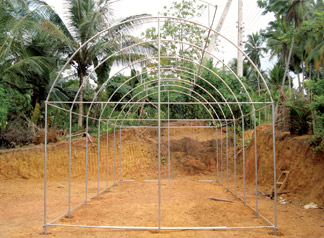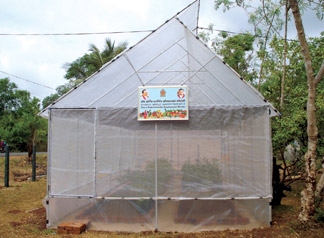|
Socio - economic development of rural sector:
Gemidiriya scales greater heights
By Jaliya WIJEYEKOON
|

S.K. Liyanage
|
The development policy of the Government, envisioned in the Mahinda
Chinthana policy framework, has focused special attention on the
fundamental issues in Sri Lanka's economic development and the disparity
between sectors and several government programs have been launched to
bridge this gap. Gemidiriya is a novel concept introduced by government
to address socio-economic grievances of the rural communities. It has
shown tremendous progress over the last six years.
The Sunday Observer had an exclusive interview with the Project
Director of Gemidiriya program S.K. Liyanage who proudly explained the
steady progress made in the rural development sector of the country.
He said there is a huge difference in the level of development
between the Western Province and the rest of the country.

Arch-shaped Poly-Net being constructed |

Poly-Net nursery |
Poverty is higher in other regions in comparison to the Western
Province and inequality is growing day by day.
The biggest problem is the unemployment rate among youth. Lack of
proper infrastructure, roads, water, community centres, ICT and
communication facilities are other key issues among rural communities.
Gemidiriya has successfully addressed these issues in a large number
of villages in nine districts and is ready to expand the project to
other districts as well.
Gemidiriya follows the community Driven Development (CDD) model in
the implementation of the project in a village. This has been recognised
as a highly successful development model and has already been replicated
in India, Nepal and Bangladesh in similar development projects funded by
the World Bank.
Under the CDD model, 80 percent of the community of a village should
participate in implementing Gemidiriya in their village. They form a
registered company as their village organisation with over 50 percent of
women and youth participation as office bearers of the various
committees in the village organisation.
After the establishment of the Gemidiriya company in the village,
they carry out a wealth ranking of the population and identify the
poorest of the poor that should be assisted first. The financial
allocation received by the Gemidiriya company is used to start income
generating projects for the most vulnerable people, skills development
of the youth, infrastructure development of the village and providing
financial assistance for the projects proposed by the people of the
area.
The project is operated by small groups and they save money in their
groups and use it as a revolving fund. Gemidiriya creates business links
among small entrepreneurs and farmers and guide them to shift from
traditional consistency farming into commercial farming. There are
thousands of success stories in this project. Gemidiriya has introduced
new crops with high market demand which has improved the income of
traditional farmers.
For instance, in Wellawaya and Buttala Gemidiriya farmers have
started passion-fruit and pomegranate cultivations which bring them a
high income. Gemidiriya has linked these farmers with supermarket chains
or other affluent buyers in Colombo.
The Gemidiriya hub office in Madulla and Siyambalanduwa in the
Moneragala district has changed traditional maize cultivation patterns
the farmers had practised for generations. Today the farmers sign
forward sales agreements with buyers before they cultivate the maize and
therefore do not face the risk of fluctuating prices at harvesting
periods. Maize cultivation has become a lucrative business in the
district today, Liyanage said.
In infrastructure development, Gemidiriya has adopted a novel
approach in the CDD model. The infrastructure development priorities are
decided by the members of the community themselves instead of the usual
top to bottom approach where bureaucrats or politicians in Colombo made
the decisions. Also, the community contribute 20 percent of the cost of
such infrastructure projects; 10 percent in cash and 10 percent in
labour.
The first phase of this innovative project was started in the
remotest villages in the Polonnaruwa district in 2004 with a US $ 51
million grant from the World Bank. A US $ 75 million loan has been given
for phase two of the project. Gemidiriya will continue over 12 years
until the targets are achieved in all districts of the country.
After reviewing the successful operation of the model.
Divi Neguma and Gama Neguma programs are also supporting the
implementation of this program in the nine districts where GSCDLIP is
operating. The project has targeted the launch of 100,000 domestic
economic units (home gardens), Liyanage said. The Divi Neguma national
program was launched in March 2011 and Gemidiriya co-ordinates the
implementation of the Divi Neguma national program in addition to
monitoring its own smooth functioning. We have the experience and
expertise to successfully contribute to this national program, he said.
Under Gemidiriya phase one, a home gardening project was successfully
carried out by beneficiaries as livelihood sub-projects. Under this
project, an environment will be created for the families to fulfil their
food requirements, improve nutrition and earn a stable monthly income.
Liyanage said "to achieve our chief objective of providing the
socio-economic standards of under-privileged people in the country, we
had carried out and still are in the process of continuing the awareness
programs, training camps and different community development activities.
Interaction with people of other areas and getting them involved in
building their future is another important aspect of our vision.
"We had introduced novel, innovative and micro methods to rural folk
to increase their harvest in crops and produce.
Educating rural youth and dispelling their fear psychosis in
venturing into new horizons is very important according to our surveys
conducted from time to time".
The Gemidiriya program was introduced in Ratnapura and Kegalle
districts early last year and the response it gained from the rural
public of these two districts was commendable. "We have appointed
district engineers and other officers to give guidelines to all
stakeholders in achieving the desired results," he said.
Kuruwita in the Ratnapura district and Deraniyalala in the Kegalle
district are two of the Pradeshiya Sabha areas that we have selected for
financial assistance in launching the second stage of the Gemidiriya
program.
Apart from socio-economic development of rural folk the
inter-communal harmony is also strengthened by the Gemidiriya program to
a great extent.
We invite the rural folk from Northern and Eastern provinces to
witness the projects initiated by people in other provinces and youth
from those provinces are sent to study the projects of Northern rural
folk by which they establish mutual understanding and sometimes life
long friendship.
"Gemidiriya has been recognised as a productive and effective program
in the implementation of the government's forward march in
socio-economic development and it will continue for years to come until
we cover all districts in the country," he said. |

